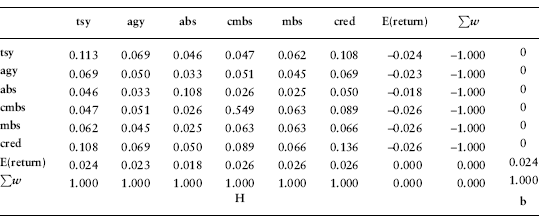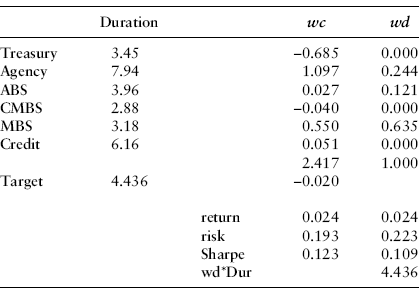A Bond Strategy
Bond managers often target a portfolio risk that is also tied to their benchmark. As we discovered in Chapter 2, a bond's duration summarizes its risk in terms of interest rate sensitivity. Bond managers who manage to a benchmark will therefore constrain the duration on their portfolio to match the benchmark duration.
![]() Go to the companion website for more details (see Bond Strategy under Chapter 7 Examples).
Go to the companion website for more details (see Bond Strategy under Chapter 7 Examples).
The bond strategy spreadsheet in the Chapter 7 Examples workbook presents such an example. These are daily total percentage returns on the benchmark and six bond indices—Treasuries, agencies, asset-backed securities, commercial mortgage-backed securities, mortgage-backed securities, and high yield corporate credit (investment grade). We will estimate a vector of mean returns and a covariance matrix to use as arguments in our mean-variance optimization.
These daily returns span April 2006 through the close of 2010. We wish to optimize a portfolio of these six bonds having a maximum return per unit risk with no short sales and with a portfolio duration that matches the benchmark duration of 4.43 years. For perspective, we also solve the minimum variance portfolio without short sales restrictions. The covariance matrix, as before, is bordered with two rows (columns) consisting of the adding up and expected return constraints so that the basic problem looks like the following:

We first solve for the portfolio ![]() . This portfolio and its expected return and risk are given further on alongside the no-short, duration-restricted portfolio (wd). The latter was solved using Excel's Solver (see the spreadsheet for details). We target maximizing the Sharpe ratio subject to two constraints: that there are no short sales (negative weights) and that the portfolio duration matches the targeted duration on the benchmark (in this case, 4.43 years).
. This portfolio and its expected return and risk are given further on alongside the no-short, duration-restricted portfolio (wd). The latter was solved using Excel's Solver (see the spreadsheet for details). We target maximizing the Sharpe ratio subject to two constraints: that there are no short sales (negative weights) and that the portfolio duration matches the targeted duration on the benchmark (in this case, 4.43 years).

The optimal daily return is 2.4 basis points on each with 22.3 basis points of risk on the duration-constrained portfolio, and somewhat less, 19.3 bps, on the unconstrained portfolio. These results should also reinforce our understanding of the cost of constraints; wd is riskier and, hence, has a smaller Sharpe ratio. Nevertheless, it tracks the constraints, especially the duration target.
A word is in order concerning return frequency. This bond portfolio is built using daily returns. Choice of frequency is not coincidental. Managers choose frequencies to match their investment horizon and its inherent risks. Quarterly and monthly frequencies, for example, will model into the covariance matrix a much different set of risk factors than will daily frequencies, for example, business cycle factors in quarterly and monthly data, seasonal factors in monthly, and temporal shocks, noise, and trading activity in daily data.
